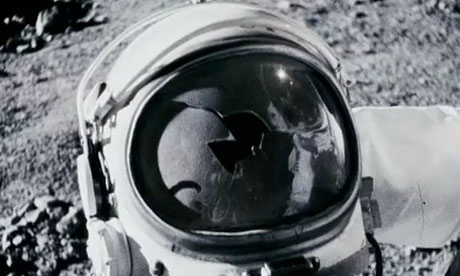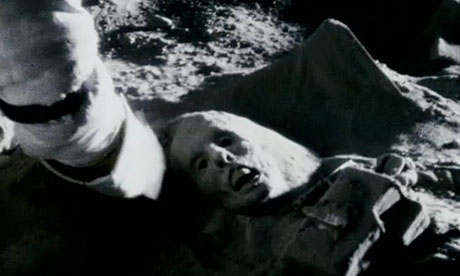I usually
get excited when a ĎMoon movieí comes along, mainly because there arenít
that many of them. That scarcity is strange, because the Moon provides a
perfect setting, not only for Horror/Sci-Fi but for all forms of
dramatic film-making. You have a severe contrast between light and dark,
an eerie stillness, constant danger.

Apollo 18
is the latest film to try to capitalise on this creepy alien
environment. It tells the story of a hypothetical Ďlostí voyage to the
Moon, said to have happened years after the Apollo program was
officially scrapped.
Three
astronauts are sent into orbit, without public knowledge, carrying a
secret payload to the lunar surface. Benjamin (Warren Christie) and
Nathan (Lloyd Owen) are to land on the surface and set up the mysterious
device, while pilot John (Ryan Robbins) holds the spacecraft in orbit
and awaits their safe return.
But the
mission goes awry when, after depositing their payload, Nathan and Ben
discover that a strange signal is blocking communications to Earth.
Exploring on their own initiative, they find a bizarre trail- beginning
with an anonymous set of footprints, and ending with an abandoned Soviet
lander which looks to have been dismantled from within. The two return
to their own lander, only to be attacked by some unseen force. Something
gets inside Nathanís spacesuit and wounds him, but afterwards Ben can
only find a few dark shards of rock.
Cut off
from Earth, with his crewmate suffering from some kind of infection and
increasingly irrational and violent, Ben does his best to get them off
the moon, and home.
The story
as told as if itís a lost piece of footage from the 70ís, and so is
shown exclusively through the use of fixed and handheld cameras. Itís a
technique that has become popular in horror movies, and used to good
effect in Troll Hunter and Cloverfield.
The
fictional sequences are blended with real stock footage from the time,
giving Apollo 18 a sense of authenticity. The sets are resplendent in
every detail, looking for all the world like actual spacecraft, and
topped off with some excellent lighting effects.

A lot of
work (and budget) has gone into special effects and CGI, which manifests
itself when the monsters are on screen. These baddies are certainly
grotesque and unsettling, but theyíre not too far from the horror norm-
nothing truly alien, or particularly terrifying.
Thankfully, the actors themselves pick up the slack when it comes to
providing scares. Lloyd Owen puts in a robust and frightening
performance as Commander Nate. The period after he becomes Ďinfectedí is
easily the best part of the movie, brimming with tension as he slowly
cracks up and loses his humanity in the confined space inside the
lander.
But the
story itself hasnít been refined quite enough, with the final sequence
especially looking as though itís been slapped together.
Audio/Video:
In order to make this look like footage from the 70ís,
the production crew have added all manner of effects and filters to the
image. The picture is consistently grainy, is full of artefacts, and
generally has a washed-out vintage look to it.
The sound is equally convincing, with all the bleeps,
whines and thuds sounding authentic.
Special Features:
-
?Deleted scenes: Some incidental
dialogue from the characters.
-
?The John Grey Memorial: An extended
reel of deleted scenes, featuring extra
-
monologues by the character John
Grey.
-
?Alternative scenes and endings: Some
different takes on some of the key scenes, including the conclusion.
(All equally unsatisfying, unfortunately.)
Closing Comments:
With its
wafer-thin story, Apollo 18 falls short of being an instant cult
classic. Nevertheless, itís worth a look for some good performances and
a persistently creepy atmosphere.
A more
robust story could have made ĎApollo 18í an instant cult hit. There are
some good performances and a few genuine scares
Apollo 18
is an interesting movie, both thematically and visually. There are some
good performances and a few good scares. Itís an interesting horror tale
that falls just short of being an instant classic.